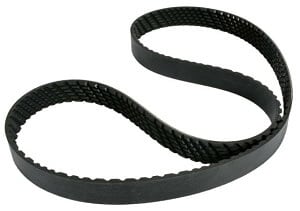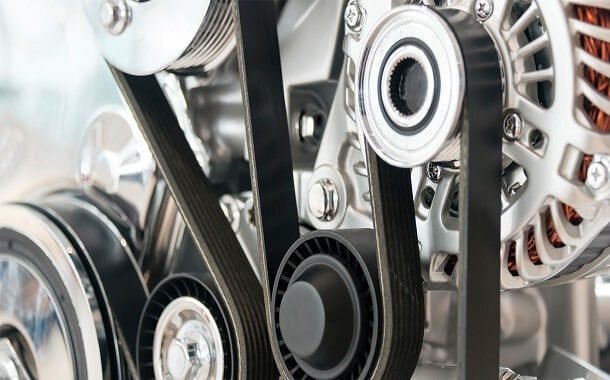Serpentine Belt Replacement Cost
Last Updated on February 21, 2024
Written by CPA Alec Pow | Content Reviewed by ![]() CFA Alexander Popinker
CFA Alexander Popinker
Just like the timing belt, the serpentine belt or drive belt is an essential element for the proper operation of the car in traffic. Even if it is just a belt, it has a very well-defined and extremely important role.
This is a component that allows the operation of a series of important parts and functions of the car such as the alternator, air conditioning, and steering. A broken serpentine belt will make it impossible to operate the hydraulic power steering and air conditioning systems leading to the car needing to be stopped. Therefore, the drive belts are necessary parts for any car due to the role they have: they reduce fuel consumption, but also carbon emissions.
You should never wait for the moment when this belt breaks. Instead, replacing this part should be part of car maintenance that should be done whenever it is deemed necessary based on a mechanic’s periodical inspection.
How much does serpentine belt replacement cost?
The average cost to replace the Serpentine belt ranges from $40 to $220 and it depends on the make and model of your vehicle, your mechanic’s pay rate, and where you live. For the new serpentine belt and other needed parts alone, you may pay around $20 to $50 but if they’re hard to access or install then that could boost the price.
According to RepairPal.com the average replacement cost for a serpentine belt is between $80 and $170, with labor estimates at around $40 to just over $100 depending on where you go. Parts will usually run from about $45-$68 if purchased separately.
A member from an online forum said they paid $20 for their serpentine belt at Autozone and it only took 20 minutes to install on their own. Another member shared that the part cost them about $75 at a local shop, while another was quoted around $160 by a dealer or even as high as $240 at Midas.
| Make and Model | Quotes Found Online |
|---|---|
| Ford Escape | $88.00-$126.50 |
| Nissan Rogue | $132.00-$192.50 |
| Ford Explorer | $88.00-$154.00 |
| Hyundai Sonata | $77.00-$143.00 |
| Scion xB | $99.00-$143.00 |
| Mini Cooper | $110.00-$154.00 |
| VW Jetta | $121.00-$192.50 |
| Mazda Mazda3 | $104.50-$165.00 |
| Nissan Altima | $77.00-$115.50 |
| BMW X5 | $137.50-$286.00 |
| Toyota Prius | $77.00-$121.00 |
| Audi A4 | $99.00-$176.00 |
| Ford F150 | $93.50-$154.00 |
| Honda CRV | $99.00-$154.00 |
| Honda Accord | $82.50-$165.00 |
| Toyota Camry | $82.50-$165.00 |
| Honda Odyssey | $99.00-$154.00 |
| Jeep Liberty | $82.50-$165.00 |
How did we get this average cost to replace a serpentine belt?
We gathered information from hundreds of different message boards and third-party quote engines to give you a better idea about how much it costs for labor as well as parts.
Serpentine belt details
The serpentine belt is an important part of the engine. It is located in front of the engine and usually under a cover. It is an important component of the engine that rotates the crankshaft and cams synchronously, ensuring that each cylinder ignites at the right time
The serpentine belt operates the fan, the water pump, the alternator, the air conditioning, but also the power steering, and the gas pump. The latest innovation in the auto market is the serpentine belt with multiple V-grooves. It differs from the others in that it reduces the loss of power in the auxiliary individual drive systems.
You might also like our articles about the cost of a power steering belt, timing belt replacement, or engine camshaft repair.
The serpentine belt is also called the drive belt, and some people even go as far as to call it a fan belt. This belt is made to connect the engine crankshaft pulley to the fan pulley, which allows the fan to rotate and cool the radiator, although it has a lot other functions as well.
The drive belt is made of hard rubber reinforced with nylon to increase its life. However, it is subjected to incredible forces inside the engine and will need to be replaced at some point. And if there is a problem with this rubber belt, the car will not work.
The condition of the belt can be checked manually by a technician, so you do not have to wait for it to break or stop working in traffic, in which case you may be prone to accidents. Usually, a belt that needs to be changed has a higher elasticity than a new belt, so a good mechanic can figure out if it needs to be changed even after a simple touch with the hand.
The serpentine belt repair process
If you do not know how to work on the engine, you will need help from an experienced professional mechanic to replace the drive belt. If you are good at mechanics, you can replace it at home by following the steps below:
- Disconnect and replace
First, disconnect the cable from the negative terminal of the battery. Remove the alternator belt and all the accessories that stand in your way to reach the drive belt. Depending on the car model, you will need to remove the power steering pump, air conditioning compressor, and valve cover.
Then, take out the Delco if the car has one. Many modern cars no longer have it because they use electronic ignition.
- Align the transmission markings
Now use a wrench to rotate the engine and align the transmission wheel markings to 0 ° on the transmission scale.
- Remove more parts
Check if you need to remove the harmonic reducer. On some models, it is necessary to remove it to change the transmission belt. Remove the screws and remove the transmission cover and other parts that are in the way of the belt.
- Remove the belt tensioner
Remove the belt tensioner by loosening it. You don’t have to take it out if you just want to check the belt.
- Check the tensioner wheel
You need to check it carefully for cracks or other signs. This wheel must be replaced first if it has a defect or has worn out.
- Remove the drive belt
As the tensioner has been removed, you will no longer have problems removing the belt from the sprockets. However, if it locks, use a screwdriver carefully to remove it from the sprockets.
- Replace
In short, replace the defective belt with a new one and reassemble it. Be sure to check the engine manually to apply the correct torque to the belt. The crankshaft wheel mounting bolt has very precise torque specifications. Pay special attention when reassembling the parts.
Replacing the serpentine belt is quite a complicated job, especially if you take into account the specific torque of some parts. Therefore, do not try to do this at home if you have no knowledge about car engines.
Common bad serpentine belt symptoms
The engine does not start
 If the car has a broken drive belt, the engine will not be able to start and work properly. You can hear the engine starter start when you turn the ignition key, but because the drive belt drives the crankshaft and camshaft, it will not start.
If the car has a broken drive belt, the engine will not be able to start and work properly. You can hear the engine starter start when you turn the ignition key, but because the drive belt drives the crankshaft and camshaft, it will not start.
In many cases, it can break when the car is running. Some of the most common faults in a car with a defective drive belt are found in the crankshaft bearings or the oil pump and cylinder head (valves, dowels, and rockers).
Engine failures
One of the signs of a bad serpentine belt that you can’t ignore is engine failure. As you know, the drive belt is attached to the drive wheels that operate the crankshaft and the camshaft.
Sometimes the drive belt slips on the camshaft, causing a cylinder to open and close earlier than it should. If you do not replace it quickly, it will lead to engine failure which will cause catastrophic damage to it.
Ticking inside the engine
The ticking noise coming from the engine is one of the signs of a malfunctioning drive belt.
Oil leaks
Oil leaks at the front of the engine are usually one of the signs of wear on a drive belt. The drive belt cover is fastened with screws that can loosen over time.
Oil leaks can also occur if the gasket between the transmission cover and the engine block is cracked, worn, or incorrectly fitted and torn. Oil leaks from the transmission cover can wear the drive belt faster and cause the engine to overheat.
How long does a serpentine belt last?
The rubber technology used in belts has improved over time, making the average belt last 100,000 miles. While this is what’s expected for most vehicles on the road today there may be an instance where you need to replace your serpentine belt before it reaches that mile marker.



Leave a Reply
Want to join the discussion?Feel free to contribute!